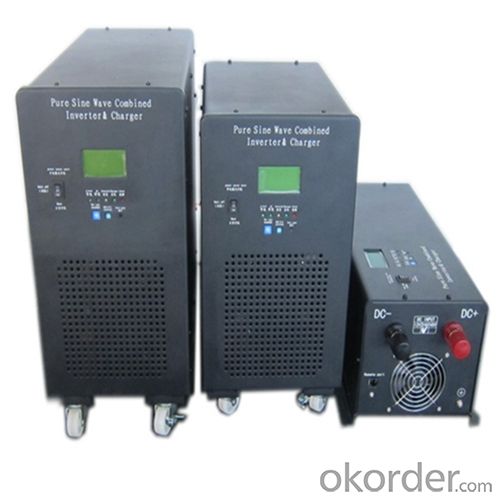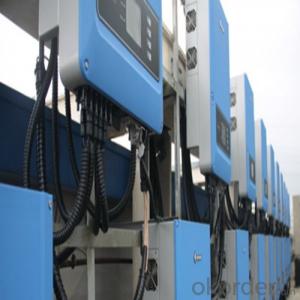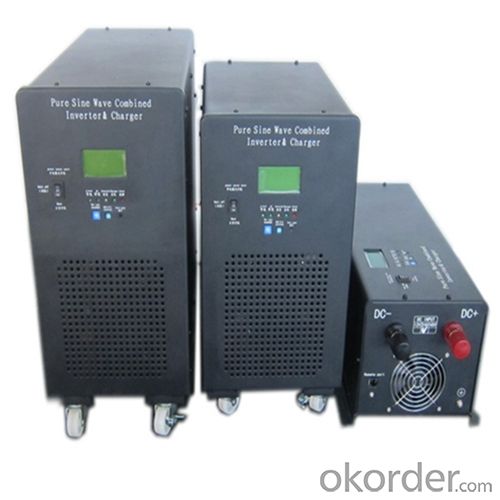1MW Solar Inverter - Certification Solar Power Inverter with MPPT Solar Charger 3000W 24V Pure Sine Wave
- Loading Port:
- Shanghai
- Payment Terms:
- TT OR LC
- Min Order Qty:
- 2 pc
- Supply Capability:
- 3000 pc/month
OKorder Service Pledge
OKorder Financial Service
You Might Also Like
Performance Characteristics
· 1. Suitable for all electrical equipments
· 2. Large LCD display for more detailed content
· 3. CPU controlled; fast transfer time
· 4. Intelligent battery management, prolonging the service life of the battery
· 5. Complete protection function, high reliability
· 6. Can provide high current charge
· 7. Can match different types of batteries
· 8. Disassembled LCD box which can make the operation in a distance of 15 meters
Product introduction
EP series is sine wave low frequency inverter, which is specifically designed for home appliances. It is equipped with a big LCD screen so all information is displayed in detail, which makes it more convenient to use. Charging current of the inverter is adjustable from 5A to 45A and you can also select different charging voltage to charge different types of batteries so batteries are under great protection.
Our Service
Samples
Samples are Available for Testing and Market Test.
Warranty
We provides warranty against defects in materials and workmanship for its Uninterruptible power supply, Power inverter/chargers including inverter12v 24v 48V, Solar charge controllers (“Product”).
OEM Service
OEM service is strictly based on the ISO9001 ISO14001 quality assurance system. The TOP involves the effective teamwork of departments from Sales, R&D, and Engineering, purchasing, production & QA, assuring a high quality product and prompt delivery for customers. The standardization of our quality system and the quality stability has earned us the trust of our customers for 12 years.
We have 10 sets of automatic insertion equipments, ICT PCB testing equipments, ATE automatic testing center and aging workshop for all products. Monthly output of UPS series exceeds 200,000. We have been offering OEM service for over 12 years.





Specifications
Input | |
Input Voltage Range | 182-265VAC |
Output | |
Input Voltage Range | Batt.Mode:50±0.3Hz Mode:48-54Hz(50Hz) or 58-64Hz,Same as AC |
Output Wave Form | Sine Wave (Batt,mode) |
Transfer Time | 10ms(Typical) |
FAQ:
Q: Do you have the CE, TUV, UL Certification?
A: We’ve already passed all the tests, and any certificate is available.
Q: Have you ever sold your products to companies in my country?
A: Of course, we have customers in all general PV markets, but I think we should expand our market share along with the market growth.
Q: When did your company set up? You are a new company, how can I believe your quality?
A: We entered into Solar PV industry in 2005, now we have several plants in manufacturing of a-Si and c-Si panels, and our capacity is 220MW per year. Till now we have already passed all the tests by authorized laboratories, e.g. TUV, CE, UL.
Q: Can you help us install the module if we cooperate with you?
A: We haven’t entered into installation sector, but we have the plan in near future.
Q: How do you pack your products?
A: We have rich experience on how to pack the panels to make sure the safety on shipment when it arrives at the destination.
Q: Can you do OEM for us?
A: Yes, we can.
Q: Can we visit your factory?
A: Surely, I will arrange the trip basing on your business schedule.
- Q: Can a solar inverter be connected to a battery storage system?
- Yes, a solar inverter can be connected to a battery storage system. This allows excess solar energy generated during the day to be stored in the batteries and used later when there is no sunlight, providing a reliable source of power.
- Q: Can a solar inverter be used in areas with high levels of electromagnetic interference (EMI)?
- Yes, a solar inverter can be used in areas with high levels of electromagnetic interference (EMI) as long as the inverter is designed and tested to withstand such conditions. Inverters with robust shielding and advanced filtering mechanisms can effectively mitigate the effects of EMI, ensuring stable and reliable operation even in challenging electromagnetic environments.
- Q: Can a solar inverter be used with different types of solar panels (monocrystalline, polycrystalline, thin-film)?
- Yes, a solar inverter can be used with different types of solar panels such as monocrystalline, polycrystalline, and thin-film. Solar inverters are designed to convert the direct current (DC) electricity generated by solar panels into alternating current (AC) electricity that can be used to power household appliances and feed into the grid. As long as the solar panel's output voltage and current fall within the operating range of the inverter, it can be used regardless of the panel type.
- Q: Can a solar inverter be used with a battery backup system?
- Yes, a solar inverter can be used with a battery backup system. The solar inverter converts the DC power generated by the solar panels into AC power that can be used to power appliances and charge batteries. The battery backup system stores excess solar energy for use during times when the sun is not shining, providing a reliable source of power even when the solar panels are not producing electricity.
- Q: How does a solar inverter protect against short circuits?
- A solar inverter protects against short circuits by monitoring the electrical current flow and detecting any abnormal increase in current caused by a short circuit. Once a short circuit is detected, the inverter immediately shuts down the power output to prevent any damage to the solar panels, the inverter itself, or the electrical system.
- Q: Can a solar inverter be used with a solar-powered pool heating system?
- Yes, a solar inverter can be used with a solar-powered pool heating system. The solar inverter is responsible for converting the direct current (DC) generated by the solar panels into alternating current (AC) that can be used to power various devices, including pool heating systems.
- Q: Can a solar inverter be used with solar-powered telecommunications systems?
- Yes, a solar inverter can be used with solar-powered telecommunications systems. A solar inverter is an essential component in converting the direct current (DC) power generated by solar panels into alternating current (AC) power, which is compatible with telecommunications equipment. This enables solar-powered telecommunications systems to operate efficiently and effectively.
- Q: Can a solar inverter be remotely monitored and controlled?
- Yes, a solar inverter can be remotely monitored and controlled. Many modern solar inverters are equipped with advanced monitoring and communication capabilities, allowing them to be connected to a network and accessed remotely. This enables users to monitor the performance of their solar system, track energy production, and make adjustments or troubleshoot issues from a remote location using a computer, smartphone, or other devices.
- Q: How does a solar inverter handle voltage fluctuations during grid disturbances?
- A solar inverter handles voltage fluctuations during grid disturbances by continuously monitoring the grid voltage. When it detects a fluctuation or disturbance, it adjusts its own output voltage to match the grid's voltage. This ensures that the solar inverter remains synchronized with the grid and delivers stable electricity without causing any damage to the connected appliances or the grid itself.
- Q: How do you choose the right size of solar inverter for a system?
- When choosing the right size of solar inverter for a system, it is important to consider the total capacity of the solar panels and the expected power output. The inverter should have a capacity that matches or slightly exceeds the maximum power output of the panels to ensure optimal efficiency. Additional factors such as the type of grid connection and any future expansion plans should also be taken into account. Consulting with a professional solar installer or conducting a thorough system assessment can help determine the appropriate size of the inverter for a given solar system.
Send your message to us
1MW Solar Inverter - Certification Solar Power Inverter with MPPT Solar Charger 3000W 24V Pure Sine Wave
- Loading Port:
- Shanghai
- Payment Terms:
- TT OR LC
- Min Order Qty:
- 2 pc
- Supply Capability:
- 3000 pc/month
OKorder Service Pledge
OKorder Financial Service
Similar products
Hot products
Hot Searches
Related keywords


























